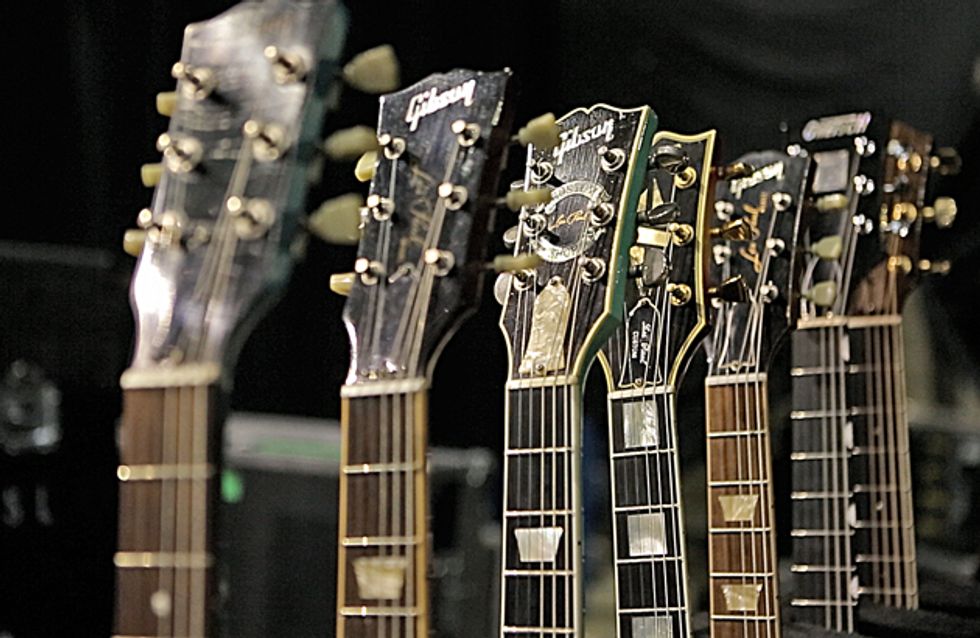A difference of a few degrees in headstock angle can have a significant effect on a neck’s production cost and structural integrity. Photo by Tony Molina.
In 2005, I was asked to create a series of limited-edition instruments to be sold exclusively through a trio of high-end shops. These guitars were to be somewhat unique and would contain some features not normally associated with the Hamer brand. The owners of the three shops were well versed in the vintage trade. Each had enjoyed great success marketing limited editions from a number of manufacturers based upon vintage aesthetics from the so-called golden age of electrics, which of course, means before 1965. Because my career had included being a vintage dealer, I was eager to get started.
The first feature was the 1950s-style ABR-1 Tune-o-matic bridge, paired with an aluminum stop tailpiece. Fair enough. Nobody is going to dismiss the sound of a vintage Les Paul so equipped, right? This is something I still use because I love the added zing of a lightweight tailpiece. On my current builds, I secure them down with 1018 steel anchors with fine-pitch threads to boot. I feel that the vibration is transferred to the body more efficiently this way, and if I had this stuff then, I would have suggested it.
The second request was for the neck to be made from a single piece of Honduran mahogany and capped with a Brazilian-rosewood fretboard. This was a bit of a departure for me, as I had developed an extremely stable and good-sounding 3-piece neck system that used pieces with opposing grain, though still matched from the same board. This technique, which I dubbed the “stressed-neck system,” had virtually eradicated any neck warp or twisting for several decades of production. Still, I understood where the guys were coming from, so a single-piece neck it was.
The theory behind a single-piece neck is that it will resonate like, well, one piece. Though I felt that in some ways it was a step backward, it wasn’t a big risk if we were diligent, and people could point to something unique about the model. We selected very nice, flatsawn pieces of 16/4 mahogany that were turned sideways to allow for the depth of the headstock. Single-piece necks are problematic if rushed to final shape, so we took our time during production and allowed the necks to rest for a few weeks at several stages along the way to prevent post-manufacture movement. The results were quite good.
The third called-for specification was to establish a peghead angle of 17 degrees. This was the detail that I found the most puzzling from a design standpoint. As I reported in a previous column (“Keeping Your Head on Straight,” July 2012), increased headstock pitch adds downward pressure and consequently holds the strings more securely in the nut slots. Some feel that this additional pressure results in better transfer of vibration to the guitar’s neck, and others swear that it adds sustain. My feeling is that it’s certainly a factor in an instrument’s overall sonic signature, but exactly how much and whether or not I could tell the difference is debatable.
One downside is the added friction can induce tuning instability by not allowing the strings to move as freely when bent, or even while being tuned. Once again, this is a marginal difference compared to, say, a guitar with a 10-degree headstock or a Fender-style instrument.
I do know for certain that a steep headstock angle represents two major things from a manufacturing standpoint. The first is that it costs more to make. As I outlined earlier, a single-piece neck requires a thicker stock, which is more expensive to obtain. But a steeper headstock costs more even when a neck is constructed from multiple boards that are laminated together. The driving force behind Leo Fender’s 1", flatsawn maple neck with effectively a zero-angle headstock was undoubtedly lowered cost.
Another factor—no doubt understood by Fender—is that the steeper the angle, the more fragile the peghead becomes. In fact, it’s said that when Gibson reduced their guitars’ headstock pitch from 17 degrees to 14 degrees in 1965, it was for just these reasons. Our shop was a Gibson service center before we became a guitar manufacturer, so my observations are not purely anecdotal. My original designs called for 14 degrees in hopes of avoiding the breakage and subsequent warranty nightmares we’d seen on Gibsons built prior to 1965. (The fact that our neck-carving machinery and tooling were bought from Gibson’s Kalamazoo factory also made this ideal.)
Still, Gibson collectors and purists who favor the 1950s-era guitars regard the steep headstock as a necessary ingredient. So even though I regarded reverting to the 17-degree angle as a bit of marketing voodoo, we all had to put food on the table and it’s sometimes hard to argue with the tidal forces of customer perceptions. My retail partners were experts in their market and I ultimately respected that. Choosing my battles wisely, the model dubbed “Triple Threat” went ahead as specified.
Looking back on this exercise, it was the collaboration with the three wise men that really made the project special for me. Working with great people and creating something memorable that will live on after we’re gone is what makes what I do worthwhile. And if you’re wondering how all the detail changes affected the sound, let’s just say that the end customers were very satisfied and leave it at that.












![Rig Rundown: Russian Circles’ Mike Sullivan [2025]](https://www.premierguitar.com/media-library/youtube.jpg?id=62303631&width=1245&height=700&quality=70&coordinates=0%2C0%2C0%2C0)









